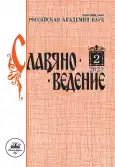编号 2 (2023)
Articles
In Memory of the Teacher
摘要
 5-18
5-18


«Time Designations» in East Slavic Etiological Legends: Lexis and Language Cliches
摘要
 19-30
19-30


Hate Speech and Church Slavonic Literature: Towards the History of the Editing of Liturgical Books in Russia (19th–20th centuries)
摘要
 31-46
31-46


 47-71
47-71


Tolstoy Conferences XXI–XXVI (2017–2022)
摘要
 72-78
72-78


On the Аnniversary of Boris Nikolaevich Florya
摘要
 79-80
79-80


Cossack Starshina of the Left-Bank Ukraine and the Image of the Poles («Liachs») in Their Perception (Records of the 1670s)
摘要
Based on the cases of the Little Russian Prikaz of the 70s of the 17th century, containing information about the participation of representatives of the Left-Bank hetmanate in peace negotiations between Russia and the Polish-Lithuanian state, the article analyzes the statements of the Left-Bank starshina about the “Poles”. They are characterized as a force with which it is impossible to have any cooperation because of their desire to oppress and destroy the “Malorossian people”. Over time, this attitude intensified, which is probably due to the ongoing changes in the position of the Cossack elite in the society of the Left-Bank Hetmanate. It was in the 70s of the 17th century, after the sharp unrest of the late 60s on the Left Bank, its position quickly strengthened, it turned into a dominant social stratum, which was threatened by the claims of the authorities of the Commonwealth to Ukrainian lands.
 81-87
81-87


Concerning the Time of Creation of the Life of Antonius the Roman
摘要
 88-101
88-101


The Petition of the Bohemian Estates to Sigismund of Luxemburg in the Year 1419: Its Pro-Hussite Orientation Revisited
摘要
The paper undertakes an analysis of the Old Czech and Middle High German versions of the petition that was sent to Sigismund of Luxemburg from Bohemia in 1419. The circumstances surrounding the composition of the petition are examined.The paper undertakes an analysis of the Old Czech and Middle High German versions of the petition that was sent to Sigismund of Luxemburg from Bohemia in 1419. The circumstances surrounding the composition of the petition are examined. The author has arrived to the conclusion that the petition has been written on the initiative of the land consuls of Bohemia who represented the Bohemian nobility. The goal of the petition was to protect the public order in the kingdom with the help of Sigismund’s influence who has been proclaimed as the «new king». As local authorities the land consuls aimed to prevent religious clashes between the Utraquists and those who sticked to the traditional Catholic rite of Communion. For this purpose they threatened to expel from the country those Catholics who called Utraquism a heresy, as well as those Utraquists who «have sworn an oath against those who call them Wyckleffits and Hussites». The Prague communities joined the land consuls in composing the petition first after the revolt of Prague against the Queen Dowager Sophie had been suppressed by the league of Catholic and Utraquist nobles. However, not every request added by the Prague Hussites has been included in the final German version received by Sigismund.
 102-114
102-114


The Idea of a Good Death in the Writings of the Bohemian Jesuits of the Post-White-Mountain Period
摘要
 115-124
115-124


Funeral Rituals of the Vlachs in the Timok Valley. Review of the Field Research in Eastern Serbia
摘要
 125-135
125-135


V. Boček, I. Janyšková, H. Karlíková, B. Vykypěl. Old Slavonic Heritage in Old Czech. Prague: NLN, 2021. 304 p.
摘要
Aleksiayevich Anna V.V. Boček, I. Janyšková, H. Karlíková, B. Vykypěl.Old Slavonic Heritage in Old Czech.Prague: NLN, 2021. 304 s.
 136-139
136-139


L. Spinozzi Monai.From the Letters of Giuseppe Loschi: The Letters to Jan Baudouin de Courtenay on the Italian Translation of «The Rezijan Сatechism» (1890–1908) = Epistolario Giuseppe Loschi: Lettere a Jan Baudouin de Courtenay sulla versione italiana del «Catechismo Resiano» (1890–1908). Ljubljana: Slovenska akademija znanosti in umetnosti, 2021. 178 s.
摘要
Yasinskaya Maria V. L. Spinozzi Monai. From the Letters of Giuseppe Loschi: The Letters to Jan Baudouin de Courtenay on the Italian Translation of «The Rezijan Сatechism» (1890–1908) = Epistolario Giuseppe Loschi: Lettere a Jan Baudouin de Courtenay sulla versione italiana del «Catechismo Resiano» (1890–1908). Ljubljana: Slovenska akademija znanosti in umetnosti, 2021. 178 s.
 140-144
140-144


Berov H. The «Balkan Japanese». Socio-Economic Profiles of Modernization and Industrialization on the Example of Serbia and Bulgaria (1878–1912). Sofia: Universitetsko izdatelstvo «Sv. Kliment Ohridski»,2020, 319 р.
摘要
Гусев Н.С. Беров Х. «Балканските японци». Социално-икономически профили на модернизацията и индустриализацията по примера на Сърбия и България (1878–1912). София: Университетско издателство «Св. Климент Охридски», 2020. 319 с.
 145-148
145-148


Conference «Religious Minorities in the Slavic Countries in the Late Middle Ages and Early Modern Times»
摘要
 149-152
149-152


On the Anniversary of Iurii Andrejevich Labyntsev
摘要
 153-154
153-154











